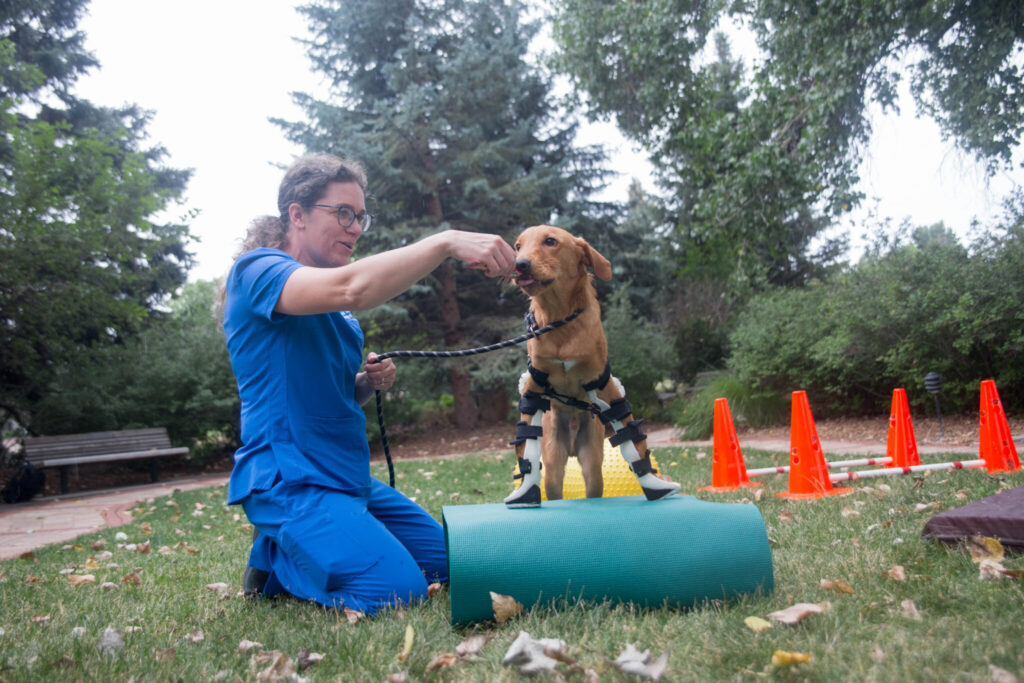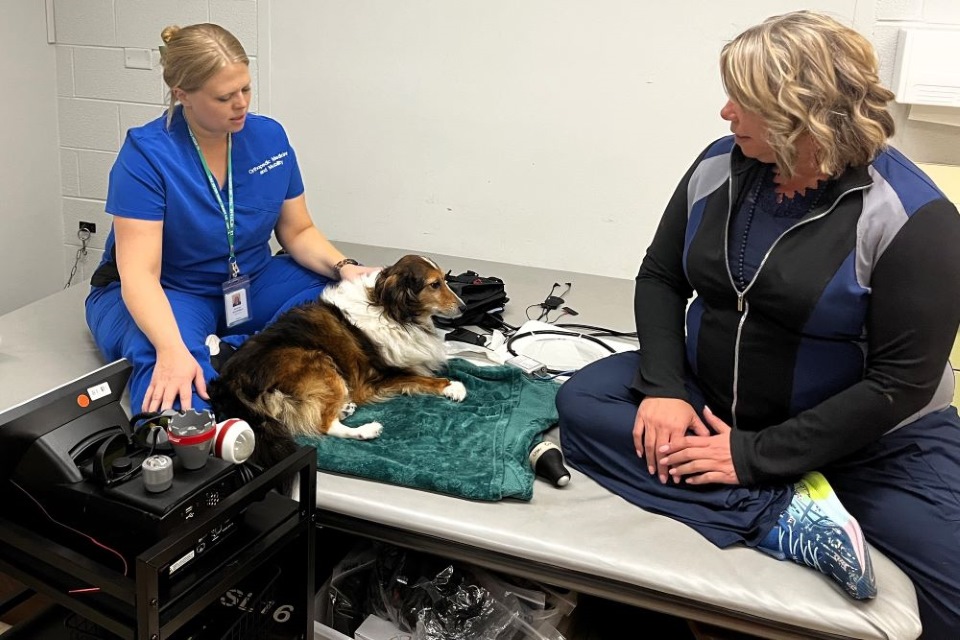
Sasha Foster, small animal rehabilitation coordinator, trained as a physical therapist – for people. Twelve years ago, she transitioned to working with dogs and shortly after, joined the CSU Veterinary Teaching Hospital to establish one of only two veterinary rehabilitation programs led by a PT at teaching hospitals in the country.
As the rehabilitation service grew, Laura Southworth joined the team with training, conditioning, and behavior expertise. Foster also trains veterinary technicians in basic therapeutics, and a few techs, like Shawn Thompson in orthopedic surgery, are cross-trained, especially in pain management.
“Any dog with mobility issues might benefit from our service, not just surgical cases,” says Southworth. “If an owner reports their pet is slowing down, we can evaluate and recommend options. Treatment planning is customized to meet our clients where they are. We can develop a plan for at-home exercises if finances are a barrier. Other clients bring their dogs to us once a week for various treatments.”

The team’s work with Tim, a rescue dog who was born with carpal flexor contractures, became an Instagram sensation, with 10 million views of the pup learning to walk.
Unique combo: Medicine, clinical trials, rehab
“When I started, I wore red so everyone could find me,” said Foster. “I waited outside the OR to let surgeons know I was ready to start working with their patients. I worked hard to build relationships, and I’m grateful to Felix Duerr, Ross Palmer, and Clara Goh for being the first to trust me with their patients.”
With support from the Veterinary Health System Clinical Services leadership, the program has grown into the vision set 10 years ago. Late last year, Dana Luery joined the team and created a clinical coordinator position from the ground up. She’s improved scheduling to get patients in sooner and has unified three separate services – orthopedic medicine, orthopedic clinical trials, and rehab – into one cohesive group.
“Another thing that makes us unique is that we offer three legs of a stool – a combination of orthopedic medicine, clinical trials, and rehabilitation,” said Foster. “We work together – veterinary specialists in sports medicine and our clinical trials team evaluating treatments to see if they improve quality of life, and we’re here to complete treatments.”
Kacie Kempkes, a veterinary technician who has completed additional veterinary rehabilitation certification, joined the team four months ago. Veterinary technician Kelly Cann is the newest team member, coming from an animal shelter in Greeley and learning rehabilitation medicine on the job.
“We have a full team in place to realize our vision of 1) providing excellent care to patients referred from all areas of the VTH, 2) providing comprehensive client education, and 3) having a good work balance – taking lunch each day and taking time off so we can come back refreshed. I’m grateful to VTH leadership for helping get us here.” said Foster.

Q&A with the Small Animal Rehabilitation Team
What do you want the VHS community to know about your service?
Laura Southworth: We offer various services, from pain management and gentle therapeutic options to more rigorous routines – we’re not all Doggie CrossFit. The great thing about Sasha is she meets people where they are at; she has high standards but is willing to adapt treatment plans considering everyone involved in the patient’s care.
What’s the best thing about your job?
Kacie Kempkes: All the cases we get to see and the improvements. I recently worked with Pipen, who wasn’t walking when we started and now is.”
Sasha Foster: I love our cohesive team. Everyone’s heart is all about making our patients feel better. We also rely on each other so much, sometimes dogs don’t always do what we have planned for the day and have to shift course and ask for help.
Laura Southworth: I love coming to work, even when I’m tired. I look forward to working with our patients and making it fun – we dance and make them feel better.
Kelly Cann: I’m the newest member of the team, and coming from shelter medicine, I’m enjoying learning a different, more therapeutic way of helping patients – using medicine in a different way.
How essential is teamwork?
Laura Southworth: Teamwork is super important. We all have different skill sets and we have to work together because treatment plans can change on the fly; at any time, I might need to hand off my patient to one of my partners.
Sasha Foster: Teamwork within and across the hospital is pivotal. Our patients come from referrals from other services. We often work with neuro, orthopedic medicine, orthopedic surgery, and oncology, and we celebrate together and cheer on our patients as they progress. It also teaches our students the power of collaboration.
Kacie Kempkes: We all have different knowledge, so I like being able to ask for ideas. It’s great to have another brain to help come up with treatment plans.
Kelly Cann: Being new, I already feel like this is my work family. Our profession can be tough, and I know I have support when it’s hard.
What’s your purpose? How do you know you’re valued?
Laura Southworth: My ultimate goal is to make dogs feel better, and I definitely see my role in that. I feel valued here and have a purpose. If I’m not here, I know I’m missed.Sasha Foster: Each day, I have two goals: 1) Doing the best work I can for each patient and 2) ensuring my team goes home feeling happy with their work.
Kacie Kempkes: I’ve been here about four months, and getting to know the docs and surgeons, I’m feeling valued as part of the team.
What are you proud of?
Kacie Kempkes: I’m proud of my accomplishments and path to get here. I started as a veterinary assistant, then became a technician, and have completed additional certification in rehabilitation, and I get to use my knowledge and experience every day to make a difference.Laura Southworth: We joke about speaking “dog.” I remember having one really energetic sled dog patient, and Sasha created a plan but was skeptical if it would work. The patient and I just really connected, and I was able to work through the plan. I’m proud when I can make that happen.
Kelly Cann: I’m proud to serve animals – that I have the skills and training to do this work.
Dana Luery: I’m proud of how far all three services have come since I started in this position 10 months ago – how they are working together as a group and now have scheduling efficiencies so we can get patients in sooner.
Sasha Foster: It’s fun to see 10 years of progress from where I started – now, we serve the entire hospital.
Veterinary Health System
Colorado State University’s Veterinary Health System is a community of veterinary professionals dedicated to providing exceptional service with passion and purpose. Our experts are animal and public health leaders working together to apply their diverse skills in veterinary care, diagnostics, and education. As a partner of CSU’s top-ranked academic veterinary program, the clinical team works with researchers and educators to advance the future of veterinary medicine.